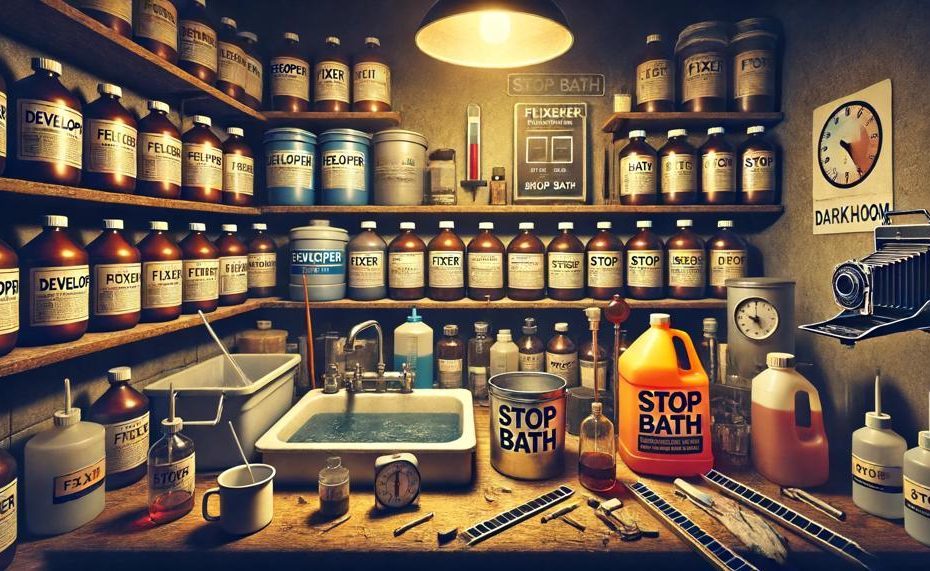The magic of developing photographs in a darkroom comes with a hidden responsibility: the proper disposal of darkroom chemicals. These substances, while essential for transforming negatives into prints, can pose significant risks to both human health and the environment if not handled correctly.
Whether you’re a seasoned photographer or a hobbyist, knowing how to dispose of these chemicals safely is a critical part of your practice.
Key Takeaways:
- Identify the Chemicals: Understand the type of darkroom chemicals you are using to determine the correct disposal method.
- Safe Drain Disposal: Some chemicals like fixer and stop bath can be diluted and flushed down the drain safely.
- Special Handling for Toxic Chemicals: Developer and toner require special disposal methods due to their hazardous properties.
- Use of Silver Recovery Units: For developers containing silver, a silver recovery unit can make the disposal process safer and more eco-friendly.
- Protective Measures: Always wear gloves, goggles, and aprons when handling chemicals, and ensure proper ventilation.
- Proper Labeling and Storage: Store chemicals in well-labeled containers away from heat and sunlight.
- Follow Local Regulations: Check with local waste management for specific disposal guidelines.
- Record Keeping: Maintain records of how and when chemicals are disposed of to ensure compliance and safety.

Contents
The Three Basic Darkroom Chemicals
The three basic darkroom chemicals are developer, stop bath, and fixer. Each plays a critical role in the photographic development process.
| Chemical | Purpose | Explanation |
| Developer | Brings out the image | The developer reacts with the exposed silver halide crystals in the film or photographic paper, reducing them to black metallic silver and revealing the latent image. |
| Stop Bath | Neutralizes the developer | The stop bath halts the development process by neutralizing the developer. Typically an acidic solution, it ensures the image doesn’t overdevelop, which helps maintain consistency and quality. |
| Fixer | Removes unexposed silver halide | The fixer dissolves and removes any remaining light-sensitive silver halide crystals from the film or paper, making the image permanent and light-resistant. |
Safety Precautions To Take When Handling Darkroom Chemicals
Proper disposal of darkroom chemicals is essential to protect both human health and the environment. Here are the key safety measures to follow:
| Safety Measure | Description |
| Training and Knowledge | Properly train on chemical risks and safe disposal methods. |
| Personal Protective Equipment (PPE) | Wear gloves, aprons, eyewear, and masks. |
| Ventilation | Ensure adequate ventilation in work areas. |
| Proper Storage | Store chemicals in labeled containers, in a cool, dark place. |
| Handling Spills | Clean up immediately and avoid environmental contamination. |
| Disposal of Spent Chemicals | Do not pour down the sink; use hazardous waste facilities. |
| Special Disposal for Silver-Containing Chemicals | Recover silver using the steel wool method and dispose of remaining liquid properly. |
| Septic Tank Precautions | Avoid pouring chemicals into septic systems; use hazardous waste facilities. |
How Hobbyists Can Dispose of Darkroom Chemicals
There are several methods for safely and environmentally-friendly disposing of darkroom chemicals. Hobbyists can ensure that their darkroom practices do not harm the environment by following these guidelines:
Hazardous Waste Disposal Facilities
Collect spent darkroom chemicals in disposable containers and take them to local hazardous waste disposal facilities. These centres are equipped to handle chemical waste safely.
Photographic Waste Recovery Programs
Some photo labs offer recovery programs. Enquire if local labs accept used chemicals for proper disposal or recycling.
Silver Recovery for Black and White Chemicals
For black and white developers and fixers, which often contain silver, use steel wool to precipitate the silver out of the solution before disposal. This not only reduces toxicity but also allows for the silver to be collected and recycled.
| Method | Procedure | Benefits |
| Hazardous Waste Disposal Facilities | Collect chemicals in containers and deliver to designated facilities | Professional handling, environmentally safe |
| Photographic Waste Recovery Programs | Contact local photo labs for disposal services | Convenient, supports recycling efforts |
| Silver Recovery | Mix used chemical with steel wool to extract silver | Reduces toxicity, recovers valuable silver |
Use Eco-friendly Chemicals
Opt for eco-friendly darkroom chemicals, such as the LegacyPro EcoPro line, which are designed to be less harmful to the environment.
Proper Storage and Labeling
Store chemicals in clearly labeled, secure containers in a cool, dark place. Ensure they are out of reach of children and pets to prevent accidental spills or misuse.
Community Hazardous Waste Events
Participate in community hazardous waste collection events. These events provide a safe way to dispose of household hazardous waste, including darkroom chemicals.
How Businesses can Dispose of Darkroom Chemicals
The necessary steps and precautions businesses should take when disposing of darkroom chemicals to ensure safety and compliance with regulations include the following:
- Wear Protective Gear: Ensure all personnel handling chemicals wear appropriate protective equipment such as aprons, gloves, and goggles to prevent direct contact and inhalation.
- Identify and Segregate Chemicals: Sort chemicals by type to ensure they are handled correctly. Pay attention to labelling and keep incompatible chemicals separate to avoid dangerous reactions.
- Contact Local Waste Treatment Centers: Reach out to local hazardous waste treatment facilities to confirm they accept darkroom chemicals and understand their specific disposal requirements. Many facilities have guidelines for businesses.
- Utilize Chemical Treatment Centers: These centers are equipped to handle and dispose of hazardous chemicals safely. Ensure you have an agreement in place for the regular disposal of darkroom chemicals.
- Private Waste Disposal Services: Some private companies offer curbside pickup for hazardous waste. These services can be scheduled to pick up darkroom chemicals directly from your business location.
- Silver Recovery Methods: For chemicals like fixer, use silver recovery systems to remove silver content before disposal. This process reduces environmental impact and can be a regulatory requirement.
- Compliance with Local Regulations: Familiarize yourself with and adhere to local, state, and federal regulations regarding the disposal of hazardous waste. In the US, Publicly Owned Treatment Works (POTWs) and certain landfills accept darkroom chemicals under specific conditions.
- Documentation and Record-Keeping: Maintain accurate records of chemical disposal activities. Documentation should include the type and amount of chemicals disposed of, disposal dates, and the name of the disposal facility or service.
- Employee Training: Regularly train employees on the correct handling and disposal procedures for darkroom chemicals. Ensure they understand the importance of safety measures and regulatory compliance.
- Emergency Preparedness: Have an emergency plan in place for chemical spills or accidents. This plan should include immediate response actions and contact information for local emergency services and hazardous waste handlers.
Finding a Waste Treatment Center Nearby
Finding a waste treatment center nearby for proper disposal of darkroom chemicals is crucial for maintaining safety and protecting the environment. Luckily, there are several easy and effective ways to locate waste treatment centers in your area.
- Contact Your Local Waste Treatment Center: The most convenient way to find a waste treatment center nearby is by contacting your local government’s waste management department. They will be able to provide you with a list of authorized waste treatment centers in your area.
- Use Online Resources: Several websites, such as Earth911 and RecycleNation, have databases that allow you to search for waste treatment centers based on location and type of waste. These websites also provide information on the types of services offered by each waste treatment center.
- Check with Private Waste Disposal Companies: If you are a business owner and need to dispose of larger quantities of darkroom chemicals, hiring a private waste disposal company may be a better option. These companies typically offer curbside pickup services and can be found through a simple online search.
- Utilize Landfills: Some landfills accept darkroom chemicals for proper disposal. Contact your local landfill to see if they provide this service.
- Consult with Trade Associations: Trade associations, such as the Society for Imaging Science and Technology, may have resources available for finding waste treatment centers that specialize in disposing of darkroom chemicals.
So, disposing of darkroom chemicals properly is not only necessary for safety and regulatory compliance, but it is also an important step in protecting the environment.
Conclusion
Disposing of darkroom chemicals responsibly is a vital practice for photographers, whether professional or hobbyist. These substances, essential for developing photographs, can harm the environment and human health if not managed correctly. Start by identifying the chemicals you use, as each type requires a specific disposal method.
Diluting and flushing certain chemicals like fixer and stop bath is acceptable, but more toxic substances like developer and toner need special handling. Utilizing silver recovery units for silver-laden developers not only makes disposal safer but also environmentally friendly. Always wear protective gear, ensure proper ventilation, and store chemicals in labeled containers away from heat and sunlight.
Local regulations vary, so consult your local waste management for specific guidelines. Record your disposal practices to ensure compliance. Remember, the impact of improper disposal is significant, potentially contaminating water systems and harming aquatic life.





